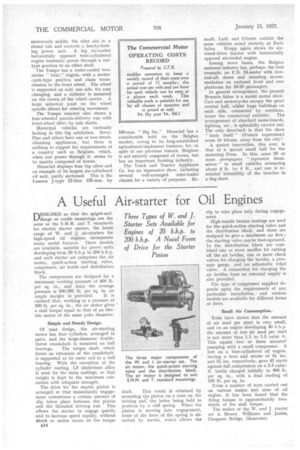A Useful Air-starter for Oil Engines
Page 48

If you've noticed an error in this article please click here to report it so we can fix it.
Three Types of W. and J. Starter Sets Available for Engines of 20 b.h.p. to 200 b.h.p. A Novel Form of Drive for the Starter
Pinion
DESIGNED so that the spigot-andflange or cradle mountings are the same as the S.M.M. and T. standards for electric starter motors, the latest range of W. and J. air-starters for high-speed oil engines incorporate many useful features.. Three models are available, suitable for power units developing from 20 b.h.p. to 200 b.h.p. and each starter set comprises the air motor, quick-action starting valve, compressor, air bottle and distribution block.
The components are designed for a maximum working pressure of 450 lb. per sq. in., and since the average pressure is 300-350 lb. per sq. in. an ample margin is provided. It is claimed that, working at a pressure of 300 lb. per sq. in., the air motor gives a stall torque equal to that of an electric motor of the same yoke diameter.
Simple and Sturdy Design.
Of "neat design, the air-starting motor has four cylinders, arranged in pairs, and the large-diameter doublethrow crankshaft is mounted on ball bearings. The torque shaft, which forms an extension of the crankshaft, is supported at its outer end in a ball bearing. With the exception of the cylinder casting, L8 aluminium alloy is used for the main castings, so that weight is kept to the minimum consistent with adequate strength.
The drive for the starter pinion is arranged so that immediately engagement commences a certain amount of slip takes place between the pinion and the threaded driving nut. This allows the starter to engage quietly and to increase speed rapidly, without shock or undue strain on the torque sI4 shaft. This result is obtained by mounting the pinion on a cone on the driving nut; the latter being held in position by a stiff spring. When the pinion is moving into engagement, some of the force of the spring is absorbed by inertia, which allows the slip to take place only during engagement.
High-tensile bronze castings are used for the quick-action starting valve and the distribution block, and these are designed to give a maximum air flow ; the starting valve can be foot-operated. In the distribution block are combined one or more needles for cutting off the air bottles, one or more check valves for charging the bottles, a pressure gauge, and an adjustable relief valve. A connection for charging the air bottles from an external supply is also provided.
The type of compressor supplied depends upon the requirements of any particular installation, and various models are available for different forms of drive.
Small Air Consumption.
Tests have shown that the amount of air used per start is very small, and on an engine developing 40 b.h.p. the amount of free air used per start is not more than 1.1 to 1.5 cubic ft. This equals two or three minutes' pumping with a small compressor. A test on a four-cylindered oil engine, having a bore and stroke of 41 ins. and 51 ins. respectively, gave 43 starts against full compression on a 2.8 cubicft. bottle charged initially to 400 lb. per sq. in., with a final reading of 150 lb. per sq. in.
From a number of tests carried out on various makes and sizes of oil engine, it has been found that the firing torque is approximately twothirds of the stall torque.
The maker of the W. and J. starter set is Messrs. Williams and James, Chequers Bridge, Gloucester.




















































































